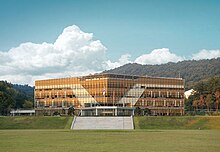
Back وكالة تطوير الدفاع Arabic Agencia para el Desarrollo de la Defensa Spanish הסוכנות לפיתוח ההגנה HE 国防科学研究所 (大韓民国) Japanese 국방과학연구소 Korean Агентство з оборонного розвитку Ukrainian 國防科學研究所 Chinese
| 국방과학연구소 Gukbang Gwahak Yeonguso | |
 | |
 Headquarters in Yuseong District, Daejeon | |
| Agency overview | |
|---|---|
| Formed | 6 August 1970 |
| Preceding agency | |
| Jurisdiction | Government of South Korea |
| Headquarters | 160, Bugyuseong-daero 488beon-gil, Yuseong-gu, Daejeon, South Korea 36°25′06″N 127°19′21″E / 36.4184077°N 127.3225271°E |
| Motto | "Defending our nation with the strength of our own science and technology!"[3] |
| Employees | 3,432 (2023)[4] |
| Annual budget | ₩1.485 trillion US$1.188 billion (2022)[5] |
| Agency executives |
|
| Parent department | Defense Acquisition Program Administration |
| Website | Official ADD website in English Official ADD website in Korean |
The Agency for Defense Development (ADD, Korean: 국방과학연구소; Hanja: 國防科學硏究所; RR: Gukbang Gwahak Yeonguso) is the South Korean government agency for research and development in defense technology, funded by the Defense Acquisition Program Administration (DAPA). It was established in August 1970 under the banner of the self-reliant national defense promoted by President Park Chung Hee.[6]
Its purpose is contributing to enforcing the national defence, to improving the national R&D capacity, and to fostering the domestic defense industry. ADD focuses on core weapons systems and core technology development, and studies major weapons platforms in high-risk and non-economical fields, unmanned and advanced, and new weapon systems for the future.
ADD is responsible for first South Korean ballistic missile Nike Hercules Korea-1 aka White/Polar Bear, developed in the 1970s with its first successful test in 1978.[7]
ADD is the operator of South Korea's first dedicated military satellite, ANASIS-II, launched on 20 July 2020 by a Falcon 9 rocket.[8]
- ^ "이승만 정권 시기 과학정책과 국방부 과학연구소 중견관리의 행정경험". The Archives of Korean History. 11 October 2013. Archived from the original on 16 June 2022. Retrieved 16 June 2022.
- ^ Moon Man-yong (2015). "Understanding Compressed Growth of Science and Technology in South Korea: Focusing on Public Research Institutes". The Korean Journal for the History of Science. 37 (2). The Korean History of Science Society: 431–453. ISSN 1229-7895.
- ^ "Mission & Vision". Agency for Defense Development. Archived from the original on 26 May 2022. Retrieved 26 May 2022.
- ^ "3. 임직원 수". Ministry of Economy and Finance. 2023. Archived from the original on 24 September 2023. Retrieved 24 September 2023.
- ^ "국방기술 연구개발 투자 1조 원 시대를 열다". Defense Acquisition Program Administration. 6 September 2021. Archived from the original on 30 May 2022. Retrieved 30 May 2022.
- ^ Kwon, Peter (2023). "Defender of the Nation, Champion of Science: The Agency for Defense Development as a Nexus for the Technological Transformation of South Korea". Journal of Korean Studies. 28 (1): 59–90. doi:10.1215/07311613-10213182. S2CID 258279383.
- ^ Mistry, Dinshaw (2003). Containing Missile Proliferation: Strategic Technology, Security Regimes, and International Cooperation in Arms Control. University of Washington Press. ISBN 9780295985077.
- ^ Anasis 2 (KMilSatCom 1)
© MMXXIII Rich X Search. We shall prevail. All rights reserved. Rich X Search